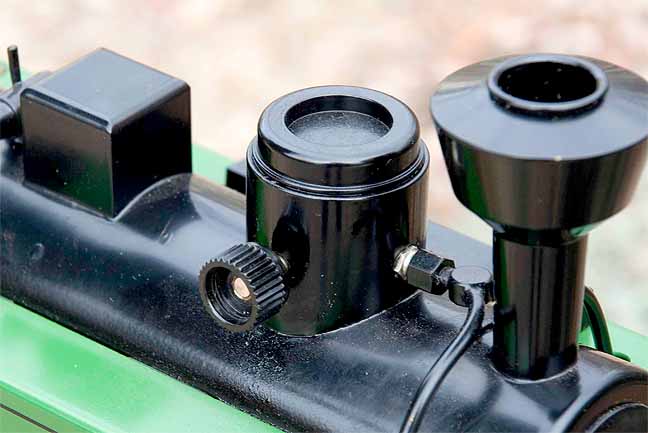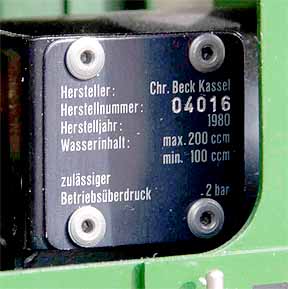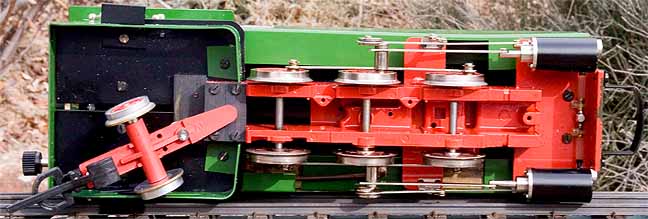
Back to Loco of the Month homepage
Back to Sidestreet Bannerworks
.
December 2009
Beck's Helene
by Marc Horovitz

Beck, Of Kassel, Germany, has been featured before in these pages with their Anna and the Merlin/Beck Matador. As mentioned earlier, Beck was a pioneer in small scale, live steam locomotives, particularly low cost, narrow-gauge engines. Their low-end locomotives were intended for use with LGB rolling stock and so were fitted with LGB-compatible couplers. Indeed, Beck produced only locomotives, relying on LGB for all remaining infrastructure -- rolling stock, track, accessories, etc.
Helene was Beck's second locomotive. It was produced in 1980, following Anna by one year. It was an 0-6-2T, suggested by (I hesitate to say modeled after) the Zillertal 0-6-2T locomotives that LGB had popularized in electricity. Beck's engine was simple in the extreme, representing the Zillertal engines mostly in rough outline. It had a trailing truck that appears to have come from the LGB factory. It is interesting to note that the flanges on the trailing wheels were turned down, evidently by Beck, to better match those on the engine.

Helene's specifications closely follow Anna's. It has two, double acting, piston-vale cylinders, controlled by outside slip eccentrics. The lubricator is a tiny reservoir in the steam dome, accessed by unscrewing the top of the dome. On the backhead is a little window into the boiler and an enormous pressure gauge. The throttle is a knob on the side of the steam dome. Butane is carried in a very large tank in the left side tank. The gas-control knob protrudes from the back of the cab.
Bodywork is straightforward, being comprised of sheet-metal shapes formed to suit. The top half of the cab is held to the bottom by three unsightly sheet-metal screws.
The boiler is a single flue, gas-fired unit, with a jet in the cab that squirts gas across an intervening air space into the back of the burner, entraining oxygen as it goes.
The run
I had a dim recollection of having tried to run this locomotive some years ago, but with no success. However, I didn't recall what the problem might have been. (I should have looked it up in my Steam Log, but didn't think of it.) Anyway, I checked it over and even tried it on air. All seemed well, so perhaps my memory was mistaken.
The temperature on steamup day was in the mid 40s -- fairly brisk. I prepared the engine in the usual manner and lit it up. The fire caught right away but refused to be adjusted beyond the weakest of flames. Oh, yeah -- memory returned -- the engine had a partially clogged gas jet that was going to be a bear to fix.
However, I had come this far, so I might as well have a go. I had to remove the upper cab to get anywhere close to the jet, which had to come out entirely to be cleared. The quarter-century-old rubber gas line was destroyed in the process of removing it. No matter- I had plenty more. The cab back had to be removed, as well. I was finally able to unscrew the jet from its mount, after which I took it into the shop and gave it a good blow out from the front end with plenty of compressed air.
I got everything back together (I only dropped one screw in the weeds) and lit it up again. This time all was well. The fire caught and could be turned up much farther than I wished, which was good. I turned it down to a reasonable setting and waited. After a little while, pressure on the big clock came up, I opened the throttle, and the engine was off.
I tied on a couple of vintage LGB coaches, which looked just right behind Helene. The train rounded the track, lap after lap, in an easy, sedate manner. Steam effects were great, due to the cold weather. It was a great run on a great day for a steamup.
Here's a movie of the engine in action. If it doesn't work, click here to go to YouTube.
|
|
|
| Builder | Chr. Beck & Söhne (Germany) |
| Date built | 1980 |
| Gauge | 1 gauge |
| Scale | 1:22.5 |
| Boiler | Single flue |
| Fittings | Safety valve, pressure gauge, throttle |
| Fuel | Butane |
| Blow-off pressure | 30 psi |
| Cylinders | Two, double acting, piston-valve |
| Reversing gear | Outside slip eccentrics |
| Lubricator | Displacement |
| Weight | 8 pounds 2 ounces |
| Dimensions | Length over end beams, 12-1/2"; width, 4-1/2"; height, 6-1/2" |










Back to Sidestreet Bannerworks home page
This page and its contents
Copyright Sidestreet Bannerworks, 2009
.